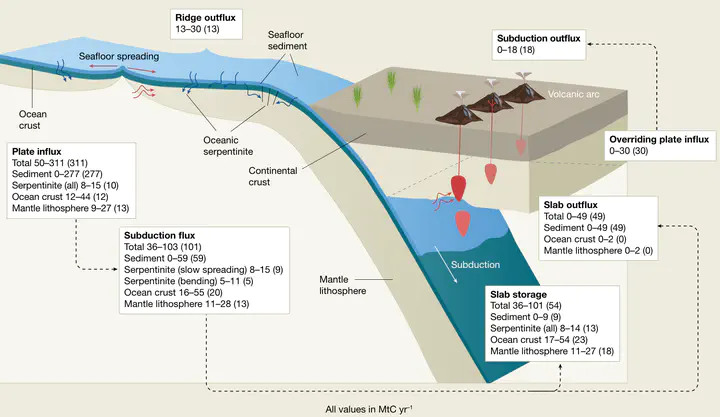Evolution of Earth’s tectonic carbon conveyor belt
 The Earth’s tectonic carbon conveyor belt shifts massive amounts of carbon between the deep Earth and the surface, from mid-ocean ridges to subduction zones, where oceanic plates carrying deep-sea sediments are recycled back into the Earth’s interior. The processes involved play a pivotal role in Earth’s climate and habitability.
The Earth’s tectonic carbon conveyor belt shifts massive amounts of carbon between the deep Earth and the surface, from mid-ocean ridges to subduction zones, where oceanic plates carrying deep-sea sediments are recycled back into the Earth’s interior. The processes involved play a pivotal role in Earth’s climate and habitability.Abstract
Concealed deep beneath the oceans is a carbon conveyor belt, propelled by plate tectonics. Our understanding of its modern functioning is underpinned by direct observations, but its variability through time has been poorly quantified. Here we reconstruct oceanic plate carbon reservoirs and track the fate of subducted carbon using thermodynamic modelling. In the Mesozoic era, 250 to 66 million years ago, plate tectonic processes had a pivotal role in driving climate change. Triassic–Jurassic period cooling correlates with a reduction in solid Earth outgassing, whereas Cretaceous period greenhouse conditions can be linked to a doubling in outgassing, driven by high-speed plate tectonics. The associated ‘carbon subduction superflux’ into the subcontinental mantle may have sparked North American diamond formation. In the Cenozoic era, continental collisions slowed seafloor spreading, reducing tectonically driven outgassing, while deep-sea carbonate sediments emerged as the Earth’s largest carbon sink. Subduction and devolatilization of this reservoir beneath volcanic arcs led to a Cenozoic increase in carbon outgassing, surpassing mid-ocean ridges as the dominant source of carbon emissions 20 million years ago. An increase in solid Earth carbon emissions during Cenozoic cooling requires an increase in continental silicate weathering flux to draw down atmospheric carbon dioxide, challenging previous views and providing boundary conditions for future carbon cycle models.
Explainer in The Conversation